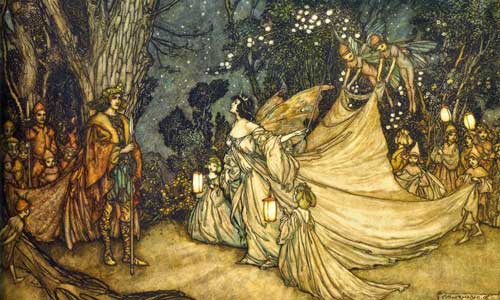AMY VAN DE CASTEELE reveals how stories of fairies differ greatly in different parts of Scotland

While legends, folk tales and fairy sightings are widespread throughout the British Isles, Scotland in particular is a land steeped in fairy lore.
From the Eildon Hills to the Highlands and the Hebrides, fairies have left an indelible mark on the countryside and in the local imagination; it is no surprise that some of the most famous fairy legends hail from Scotland. A number of local accounts have been reported of people encountering the fairy queen herself, either riding abroad or welcoming visitors to her court inside one of the hollow hills.
Some of these accounts cast the queen in a positive light, as a bringer of bounty; while in others, she is more like a harpie in her cruelty and ruthlessness.
Read on to learn more about two of the most famous Scottish legends, which, taken together, demonstrate the vastly different depictions of the Queen of Elfland. As you come face to face with this fair and terrible monarch, you’ll soon discover that the road to Faerie has many beginnings, but it is a road that should only be taken by the very brave, or the very foolhardy… and once you have taken it you will never be the same again.
Thomas the Rhymer
Thomas of Erceldoune, also known as Thomas the Rhymer, is arguably the most famous Scot to have encountered a fairy and entered Faeryland. He was lying one bright sunny day under a hawthorn tree (known for its fairy associations) on Huntly Bank when a stunningly beautiful woman dressed in green came riding by on a noble steed with bells plaited into its mane. Thomas, enraptured by her loveliness, called out to her rather boldly, ‘All hail, thou mighty queen of heaven! / for your like on earth I never did see! The woman checks her horse and answers, ‘O no, O no, Thomas. That name does not belong to me.’
She is not the Queen of Heaven after all, but the Queen of Elfland, and by addressing her Thomas has unwittingly put himself into her power. Not that he seems to mind very much. In fact he quite willingly agrees to go with her and serve her for seven years, hopping up onto her snow-white steed and riding off with her on an arduous journey, which takes 40 days and 40 nights and involves the horse wading through red blood up to his knees.
During his sojourn in Elfland Thomas is not allowed to speak, but despite this he and the queen seem to build up a strong bond, so much so that after 7 years she returns him to the mortal world and grants him mighty gifts of prophecy and enhanced speech. Because of this he is also known as ‘True Thomas’, for he cannot tell a lie and whatever he prophesies comes to pass.
Tam Lin
Linked to the tale of Thomas the Rhymer is the evocative story of Tam Lin, a fairy legend that neatly inverts the usual trope of a damsel in distress being rescued by a bold and handsome suitor. This time, it is the handsome suitor who needs rescuing, from none other than the Queen of the Fairies, who, in this legend, is not half so sweet or charming as Thomas’s ‘Queen of Heaven’.
West of the Eildon Hills, where Thomas lived, you will find Carterhaugh, located near the glittering confluence of the Ettrick and Yarrow Waters. Here in the woods it was said that a handsome fairy knight named Tam Lin lurked, preying upon young women and robbing them of their jewelry, their mantles or their maidenheads. Now this might put off most girls from venturing into the woods, but not young Janet. Instead she boldly made her way to a well which stood among the trees and picked a rose, which instantly summoned the fairy knight called Tam Lin, who turns out to be a mortal man trapped by the Elf Queen. Janet falls in love with Tam Lin and becomes pregnant by him; subsequently, she determines to rescue him from the clutches of the cruel queen, whom Tam Lin fears is planning to use him as her tithe to the Devil on Halloween.
He instructs Janet to go to Miles Cross and watch out for the riding of the fairies ‘at the mirk and midnight hour’ and gives her various signs by which she will recognise him: he will be riding a milk-white horse, he will be wearing a glove only on his right hand, his bonnet shall be ‘cockt up’ and his hair shall be combed down.
Janet duly goes to Miles Cross that night and when Tam Lin comes riding by with the fairy company she pulls him off his horse. Tam Lin is turned into a number of monstrous beasts by the magic of the fairies and, finally, into a ‘burning gleed’, which Janet throws into the well and then covers with her green mantle, thereby winning her love.
In fury the Queen of Elfland cries out ‘Shame betide her…/ …an ill death may she die / For she’s ta’en awa the bonniest knight / In a’ my companie…’ and to Tam Lin she says if she had known what would happen, ‘I wad hae ta’en out thy twa grey een / And put in twa een o tree.’ A fearsome woman to cross indeed!
These two stories cast the fairy queen in a dramatically different light, and each boasts poignant connotations and deeper meanings linked to contemporary views of masculinity, female power and female sexuality, which are well worth exploring. But on their surface level they are entertaining, vibrant accounts of magic and fairy majesty, though they also come with a clear warning; if you do happen to meet the Queen of Elfland, it is best to stay in her good books!
Tell us your thoughts on this article in the comments section below!









